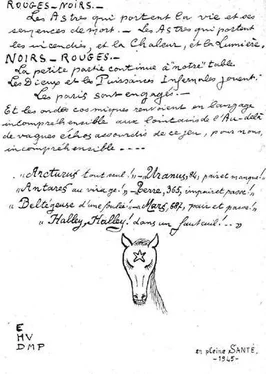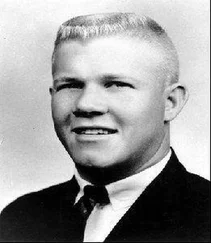In 1937, when the International Exposition had returned to Paris, Massu established the “Brigade Volante,” a mobile police squad to fight crime, which had risen dramatically at the 185-day World’s Fair that drew some 31.5 million registered visitors. Massu tried to make sure that this “ritual of Peace and Progress” would not be scarred by murder or tragedy. He averaged about three hundred arrests per month, but in one key respect, Massu and all his colleagues had not succeeded.
A German drifter named Eugen Weidmann had been luring tourists away to a small villa west of Paris, at St. Cloud, where he killed and robbed his six victims and then buried most of them in his basement. Weidmann was eventually caught, sentenced to death, and guillotined in June 1939. The massive, unruly crowd outside St. Pierre’s prison at Versailles that day would prompt the French president LeBrun, nine days later, to abolish public executions.
Now, four and a half years after Weidmann, there was another serial killer in Paris, this one more prolific and far more disturbing.
WITH the order from the German authorities in hand, Commissaire Massu hurriedly drafted a warrant for the arrest of Marcel Petiot and his wife, Georgette. The latter was described as “about forty years old, small stature, light complexion, thin face.” Dr. Petiot, age forty-seven, was presented as being “about 180 cm [just under 5′11″], rather corpulent, dark chestnut brown hair, thrown back, slight frontal baldness, clean-shaven, strong jaw, chin slightly prominent, and wearing a large overcoat.” Petiot is, the notice warned, “considered dangerous.”
“The steps of an investigation,” Massu said, “are always the same: statements, interrogations of witnesses, picking up clues and fingerprints at the scene of the crime and everywhere it seems necessary.” All of this would be “compared and examined scientifically,” looking for “anything that can be useful to the demonstration of the truth.” As for finding the suspect, Massu was confident. No matter how clever a murderer had been, how perfect his plan, or flawless its execution, a murderer was always, at some point, “an idiot.” A mistake would eventually be made and he would pounce.
Investigator Marius Battut and a couple of homicide detectives headed to Petiot’s apartment on rue Caumartin, which was not too far from the métro stations Caumartin and Saint-Lazare. The apartment was in the middle of the lively Opera District, full of hotels, restaurants, cafés, theaters, nightclubs, brothels, and many other commercial establishments on and around the Boulevard Haussmann.
The officers walked up to the five-story building at No. 66. Two businesses were on the ground floor: the hairdresser salon Gaston Coiffure and the bistro La Chope du Printemps. An air raid shelter was in the basement. To the right of the front door was a black marble plaque with engraved gold letters advertising the medical practice and office hours of Dr. Petiot, a graduate of the University of Paris Medical School.
The bistro, the hair salon, and Petiot’s practice were all closed. The concierge, Raymonde Denis, happened to be away from her lodge when the police team arrived. Her twelve-year-old daughter, Alice, on the other hand, told the officers that she had seen Marcel Petiot and his wife, Georgette, about nine thirty the previous night, when they had returned home together on foot. She thought that they might still be in their apartment.
The officers walked up two flights of stairs and knocked. No one answered. The door, the officers discovered, was unlocked. Later the police would learn that Petiot never locked his doors, because a skilled burglar, he reasoned, would always find a way inside, and this way, he would not have to make repairs. The police, however, did not enter.
Although they held a warrant for the arrest of the couple, and authorization to search rue Le Sueur, they did not have permission to search Petiot’s apartment. The Germans might flaunt French laws, but Battut was determined to follow procedure. On their way back to the headquarters to obtain the necessary paperwork, the officers met Petiot’s concierge.
“Yesterday evening,” thirty-nine-year-old Raymond Denis said, “I saw Dr. Petiot for the last time at seven o’clock.” He was leaving the apartment on his bicycle. About eight o’clock, Georgette had stopped by the concierge lodge with some cakes for her daughter. Madame Denis did not know anything else about the evening, other than the fact that at about nine thirty p.m., after she had gone to bed, her daughter said that she had seen Marcel and Georgette come home.
When the police officers returned to rue Caumartin the following morning with the search warrant, there was no one there. In contrast to the chaos at rue Le Sueur, the rooms here were neat and tidy. Papers, personal belongings, and other objects of value were conspicuously absent. What they did find was a large supply of coffee, sugar, chocolate, and spirits, all difficult to obtain in wartime Paris—a veritable prewar café, Massu said. There was also a variety of prescription drugs and narcotics, including peyote, a hallucinogenic drug popular in Parisian nightclubs, and some 504 vials of morphine, worth a fortune on the black market.
This was a large amount, even for a physician who, as reports indicated, claimed to treat drug addicts in his practice. Was Petiot a drug user himself? Was he dealing in drugs on the side? Early rumors suggested that Petiot catered to a diverse clientele, and his office was located in a notorious drug district. Physicians, too, investigators knew, were the most readily available source of illegal drugs in Occupied Paris.
In addition, the inspectors found a collection of bizarre artwork and a number of masks described as “diabolical and grimacing.” On a pedestal in the doctor’s office, between the cupboard and the wall, was a wooden statue, about two feet in height, of a beast, a devilish or Pan-like creature with a grotesquely large phallus. Dr. Petiot, police soon learned, was the artist.
4.
TWO WITNESSES
THE REIGN OF BEASTS HAS BEGUN.
—Albert Camus, Notebook , September 7, 1939
MARCEL Petiot had indeed been selling drugs. By March 1944, no fewer than ninety-five registered drug addicts were attending his “detoxication program” at rue Caumartin, ostensibly to be cured of their addiction by a series of increasingly smaller doses. Petiot had gained a reputation for this treatment and also for being a sympathetic doctor who indulged his patients. His waiting room was regularly packed. Georgette, who did the bookkeeping for the practice, was busier than ever.
Massu now learned that Petiot had a sizable file with the Brigade Mondaine, a specialized force of the Police Judiciaire that dealt with, among other things, prostitution, procurement, pornography, and drugs. In early 1942, in another periodic clamp-down on the rampant illicit drug trade in Paris, the Brigade Mondaine had launched a campaign to arrest suspected addicts. Among the people taken into custody was one of Petiot’s patients, and the subsequent inquiry had raised a number of questions about the physician, which, in light of the later investigation, would prove to be a key piece of evidence.
The patient was Jean-Marc Van Bever, a forty-one-year-old coal deliverer. This was his first steady job, gained only a few months before, with the rising demand for this scarce resource to heat offices, apartments, and other buildings. Previously Van Bever had invested his inheritance into a number of printing businesses that had gone bust. For most of the late 1930s, he had lived in poverty, eking out an existence thanks to social welfare and various charities. This was an unexpected result for a man of his background.
Читать дальше












